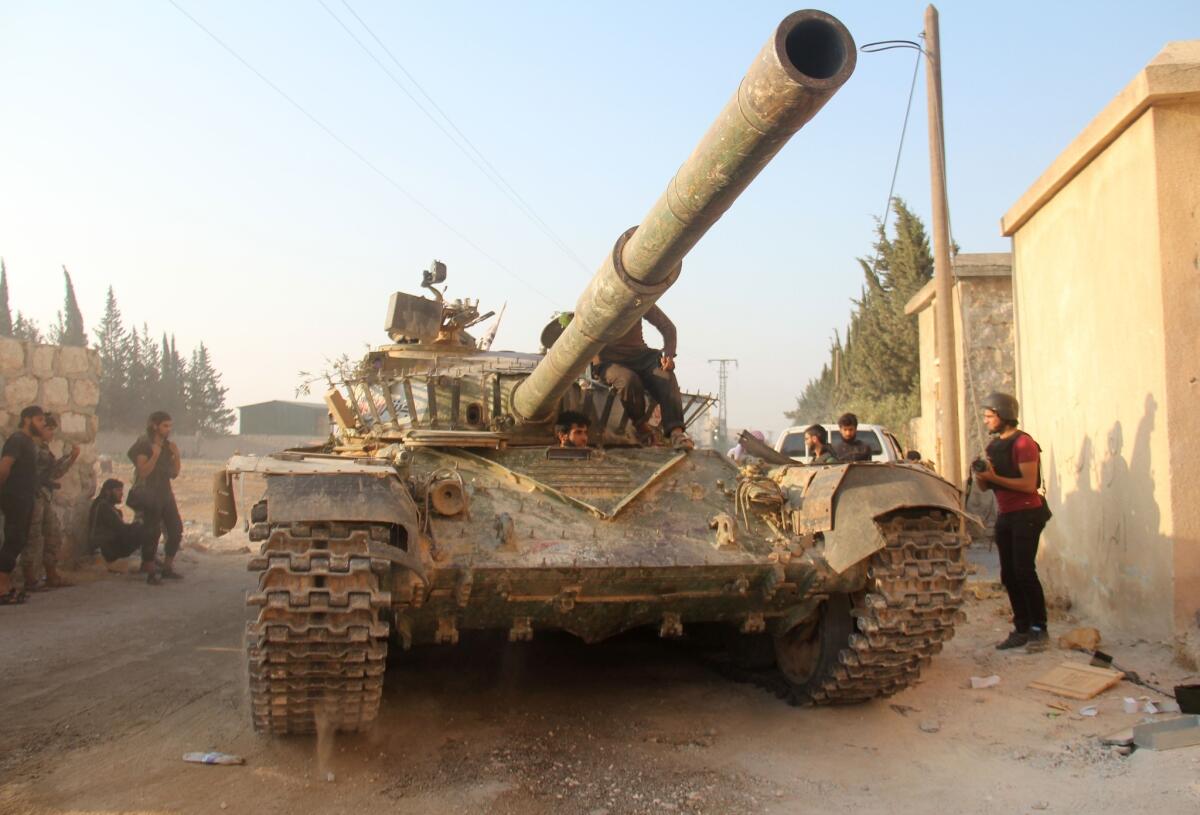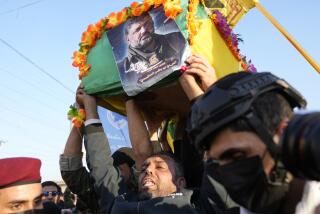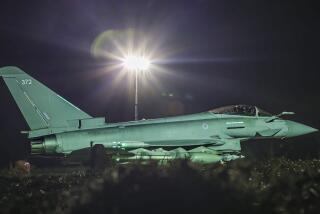Al Qaeda-founded rebel group’s growth underscores U.S. challenges in Syria

As Islamic State has lost fighters and territory over the last year, an Al Qaeda-founded militant group in Syria has grown in strength, establishing a reputation as the most ferocious fighting force against Bashar Assad’s government.
The militant group formerly known as Al Nusra Front has expanded, in part, because its fighters also oppose Islamic State on the battlefield and are rarely targeted in airstrikes by U.S. and coalition aircraft, American officials say.
In recent weeks, U.S. intelligence has detected signs that Al Qaeda operatives in Syria are plotting attacks against the West, raising concerns that the hard-line Islamist group has escaped scrutiny for too long, according to two U.S. intelligence officials who spoke on condition of anonymity to discuss sensitive information.
Al Nusra Front, which recently renamed itself the Front for the Conquest of Syria in an effort to distance itself from Al Qaeda, highlights the difficulty the White House has faced trying to find reliable allies in a vicious civil war that pits dozens of armed groups against one another, the terrorist group Islamic State and Assad’s government in Damascus.
“We’re not fighting Al Nusra,” Col. Christopher Garver, spokesman for the U.S.-led coalition in Baghdad, said in a recent teleconference with reporters. “We are fighting Daesh,” he said, using an Arabic acronym for Islamic State.
The only exceptions are known Al Qaeda leaders. On Tuesday, the Pentagon announced that a U.S. drone strike had targeted and killed Ahmad Salamah Mabruk, a veteran Al Qaeda operative who had co-founded Al Nusra.
Mabruk had close ties to Ayman Zawahiri, the Egyptian-born doctor who took over Al Qaeda after Osama bin Laden was killed in a CIA-led raid in Pakistan in May 2011, according to U.S. officials.
U.S. intelligence officials say the Front for the Conquest of Syria now has up to 10,000 fighters in Syria, about the same as Islamic State has in the country. But while Islamic State has lost territory, the Front has gained ground in Idlib province along the Turkish border.
In June, Brett McGurk, President Obama’s envoy in the campaign against Islamic State, told the Senate Foreign Relations Committee that Al Nusra had become “Al Qaeda’s largest formal affiliate in history,”
Two years ago, the Obama administration launched its first air attacks in Syria by targeting a small group of Al Qaeda operatives known as the Khorasan Group. Coalition airstrikes have targeted other known Al Qaeda figures since then, but have generally given the Al Nusra/Front fighters a pass.
Because Front for the Conquest of Syria militants are fighting Assad, as well as Islamic State, they often are pushing in the same direction as CIA-backed rebel forces in northwest Syria. That also has made them harder to isolate as targets. The factional bases are often close together.
In Aleppo, a city that has come under intense bombardment by Syrian and Russian aircraft in recent weeks, Front fighters often operate side by side with the so-called moderate opposition forces that receive U.S. arms and other support.
There is “mixing of some members of the moderate opposition with Nusra,” Mark Toner, the State Department spokesman, said Tuesday. “Part of that is exacerbated by the fact that when the regime attacks the [moderates], they’re defending themselves. And frankly … it drives them into the arms of the extremists.”
Because of its growing strength, the Front has become a lightning rod for Syrian government forces backed by Russian aircraft and missiles.
On Thursday, Staffan de Mistura, United Nations special envoy for Syria, issued an appeal for an estimated 900 Front fighters to leave rebel-held eastern Aleppo, arguing that their presence gave Russian and Syrian warplanes an “easy alibi” to raze the city.
“If you decide to leave with dignity … I am personally ready to physically accompany you,” De Mistura said in Geneva. An estimated 275,000 civilians are believed to be besieged in eastern Aleppo.
“There is only one thing we are not ready to do: be passive, resign ourselves to another Srebrenica, another Rwanda, which we are sadly ready to recognize written on that wall in front of us, unless something takes place,” De Mistura said.
Both the U.N. and the United States, as well as Syria’s government, consider the Front for the Conquest of Syria a terrorist group.
Experts say, however, that the group presents a very different profile than Islamic State. Unlike Islamic State, which mostly consists of foreign fighters, the Front’s ranks are mostly filled with homegrown Syrian jihadis.
Perhaps for that reason, it has governed with less barbarity in areas under its sway. In the provincial capital of Idlib, the Front allowed locals to manage day-to-day administrative affairs, easing the transition to insurgent control.
“Islamic State simply doesn’t work with others, but the group formerly known as Nusra has always sought consensus,” said Rania Abouzeid, a Lebanese journalist who visited Front-held areas in northern Syria this year.
Its suicide bombers have targeted Assad’s forces in offensives launched in concert with other rebel groups’ assaults, for example, experts say.
“Nusra has seized upon the fractured nature of the Syrian conflict by syncing up with other groups,” said Jennifer Cafarella, a Syria analyst at the nonpartisan Institute for the Study of War in Washington. “Now these groups need Nusra to survive on the battlefield and will work alongside them – even though they don’t often agree with Al Qaeda’s long-term goals.”
In July, the group sought to publicly rebrand itself in an online video by changing its name and declaring that it had cut all “external” ties to Al Qaeda. The group’s leader, Abu Mohammed Jolani, who wore army fatigues and a white turban, showed his face for the first time.
The announcement did not convince U.S. counter-terrorism officials, who noted that Jolani did not withdraw his loyalty pledge to Al Qaeda.
U.S. officials believe the rebranding was aimed at easing concerns of other Syrian rebel groups who don’t buy into Al Qaeda’s apocalyptic view.
Although its media is not as sophisticated as that of Islamic State, the group also upgraded its online and social media operation. It was one of the first rebel groups to integrate small drones and GoPro combat video in its media, and it recently appointed an English-speaking spokesman. It also created an encrypted mailbox where outsiders can communicate with the group.
It’s not known whether the group’s changing profile led to the U.S. drone strike that killed Mabruk, who co-founded Al Nusra with Jolani, as he drove Monday in Jisr al Shugur, a town in Idlib province where Al Nusra and other rebel groups overran Assad’s forces last year.
“It represents a continuation of our counter-terrorism efforts, particularly focused on Al Qaeda leadership,” Peter Cook, a Pentagon spokesman, said Tuesday. “That’s been a goal of the U.S. government since 2001.”
U.S. officials say Mabruk had close ties to Zawahiri, Bin Laden’s successor. He had been known to U.S. intelligence for nearly two decades.
In 1998, the CIA snatched Mabruk from Azerbaijan and got access to his laptop. It contained a trove of data on Al Qaeda connections so valuable that it became known inside the agency as the Rosetta stone for Al Qaeda at a time when U.S. intelligence knew very little about Bin Laden’s terrorist network.
Mabruk was imprisoned in several countries from 1998 until 2011, when he was released from jail in Egypt after the “Arab Spring” uprising. U.S. officials say he then regained Zawahiri’s trust and rejoined Al Qaeda’s leadership before he was sent to Syria to set up a franchise.
“The Syrian war has been a breeding ground for Al Qaeda and its version of jihadism,” said Thomas Jocelyn, a senior fellow at the Foundation for Defense of Democracies, a Washington think tank.
“Let that fact sink in,” he said. “Here you are in 2016, 15 years after Sept. 11, and Al Qaeda has the largest guerrilla army in its history answering directly to Zawahiri.”
Times staff writers Bennett and Hennigan reported from Washington and special correspondent Bulos reported from Beirut.
Twitter: @wjhenn
More to Read
Start your day right
Sign up for Essential California for news, features and recommendations from the L.A. Times and beyond in your inbox six days a week.
You may occasionally receive promotional content from the Los Angeles Times.









